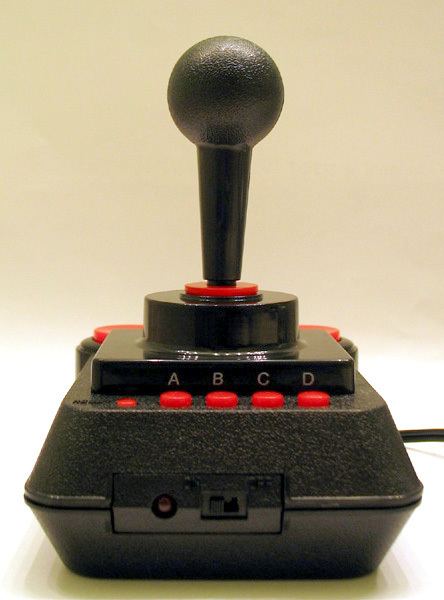 | ||
The C64 Direct-to-TV, called C64DTV for short, is a single-chip implementation of the Commodore 64 computer, contained in a joystick (modeled after the mid-1980s Competition Pro joystick), with 30 built-in games. The design is similar to the Atari Classics 10-in-1 TV Game. The circuitry of the C64DTV was designed by Jeri Ellsworth, a self-taught computer chip designer who had formerly designed the C-One.
Contents
Tulip Computers (which had acquired the Commodore brand name in 1997) licensed the rights to Ironstone Partners, which cooperated with DC Studios, Mammoth Toys, and "The Toy:Lobster Company" in the development and marketing of the unit. QVC purchased the entire first production run of 250,000 units and sold 70,000 of them on the first day that they were offered.
Versions
There exist multiple versions of the C64DTV. DTV1 (NTSC television type) comes with 2 MB ROM. It first appeared in late 2004 for the American/Canadian market. DTV2 (called C64D2TV sometimes) is a revised version for the European and world markets (PAL television type) and appeared in late 2005. The ROM has been replaced by flash memory in these devices. However, the DTV2/PAL version suffers from a manufacturing fault, which results in poor colour rendering (the resistors in the R-2R ladder DACs for both the chroma and the luma have been transposed). In the DTV3, a problem with the blitter was fixed.
Hardware Specifications
Built-in games
The official games for the unit are mostly a mix of Epyx and Hewson C64 games. Games unique to the NTSC or PAL versions are noted below.
Hardware-modding
Since the internal circuit board has exposed solder points for floppy-drive and keyboard ports, hardware modifications of the C64DTV are relatively simple.
Known hardware mods
Additional hardware
Limitations
The internal flash memory is accessible as device 1. However, software is not included to support write operations so high-score saving is not possible. Also, flash devices used in the DTV are specified for a very limited number of write accesses only.
When using the standard keyboard mod, the F7 key does not work. There is a workaround, the "Keyboard Twister."
Software-modding
The DTV contains software-flashable memory. A number of tools have been released to compile programs into DTV-compatible flash images and load it onto the DTV. People made their own game compilations, adding popular (sometimes DTV-fixed) games that were not in the original DTV, added boot menus to make homebrew software development easier or enable new features, for example transfer programs like DTVtrans for transferring data from PC to DTV RAM and vice versa via the PC parallel port (or USB) and the DTV joystick port.
